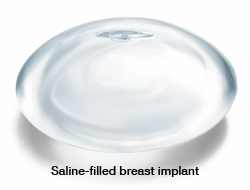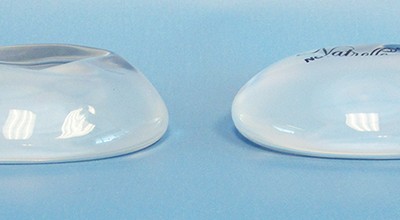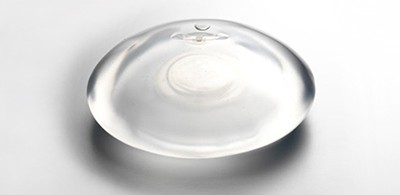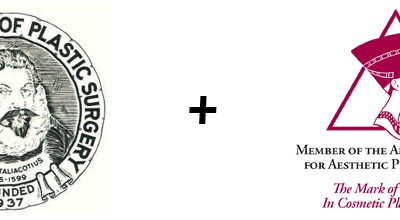
Saline & Silicone Gel Breast Implants
Breast Implants are Filled with Saline Solution or Silicone Gel
There are two types of breast implants available in the United States; those filled with a salt-water solution, and those filled with a silicone gel. All of these breast implants are approved by the FDA. Saline breast implants were approved in 2000, round silicone gel implants in 2006, and anatomic-shaped silicone gel implants in 2012 and 2013.
The outer shell of all breast implants is made of a thin silicone elastomer, the surface of which is either smooth or textured. The implant shell is then filled with saline solution or silicone gel. The densities of saline and silicone gel differ slightly, but are close to the density of breast tissue.
Saline Breast Implants
Saline breast implants are filled, by the operating surgeon, with sterile injectable 0.9% saline; the same saline solution used for intravenous infusion. The surgeon places the empty breast implant into the pocket and then fills the implant to the desired volume using a specially designed tube. When the desired volume is achieved, the fill-tube is removed and the anterior valve is covered. Each saline implant has a minimal fill volume, but it may be overfilled slightly at the discretion of the operating surgeon.
The consistency or firmness of a saline-filled breast implant is directly related to the fill volume. As the volume of a saline implant increases, the firmness of the implant also increases. All saline implants feel firmer than breast tissue when they are filled to a point where there is minimal wrinkling of the implant shell. (note: this point of minimal wrinkling occurs at a volume which is greater than the minimal fill volume specified by the manufacturer) Saline implants have an inherent tendency to ripple, and are more easily felt behind the breast tissue; for this reason saline implants should be placed behind the muscle. Saline-filled breast implants are indicated for women at least 18 years of age.
There are now two types of saline-filled breast implants. The traditional (classic) saline implant has a single shell that encompasses a single lumen that is filled from the anterior surface. At the fill volume specified by the manufacturer the traditional saline implant has moderate rippling. The newer “structured” saline implant has been designed to improve upon the classic design. The structured saline implant has multiple shells and two lumens. The larger volume inner lumen is filled from the posterior surface of the implant. The smaller volume outer lumen is filled from the anterior surface of the implant. Contained within the outer lumen are one or two additional shells that function as baffles to reduce rippling. This structured saline implant is marketed as the Ideal Implant and was designed to provide a feel and consistency that closely mimics a silicone gel implant, but has the failure characteristics of a saline implant.
Silicone Gel Breast Implants
Silicone gel breast implants are filled by the manufacturer, and a posterior silicone patch seals the implant. The surgeon must therefore carefully place the full volume implant through the incision into the pocket.
![]() Round silicone gel breast implants contain a moderately-cohesive and “responsive” silicone gel filling. Anatomic silicone gel breast implants contain a highly-cohesive, “form-stable” gel filling. Within a given implant style, the consistency of a silicone gel implant does not vary because each is filled the same amount. Compared to a saline breast implant, the responsive nature of the silicone gel filling creates a more natural feeling breast. Patients consistently select silicone gel-filled implants as having the most natural feel and consistency. Silicone gel breast implants demonstrate less rippling than saline implants.
Round silicone gel breast implants contain a moderately-cohesive and “responsive” silicone gel filling. Anatomic silicone gel breast implants contain a highly-cohesive, “form-stable” gel filling. Within a given implant style, the consistency of a silicone gel implant does not vary because each is filled the same amount. Compared to a saline breast implant, the responsive nature of the silicone gel filling creates a more natural feeling breast. Patients consistently select silicone gel-filled implants as having the most natural feel and consistency. Silicone gel breast implants demonstrate less rippling than saline implants.
Today’s round silicone gel implants are considered fourth generation devices and offer many features and advantages over earlier silicone gel-filled implants. Anatomic silicone gel implants are considered fifth generation devices and potentially offer even further advantages over round silicone implants. Silicone gel-filled breast implants have been the most popular implants in Europe, Canada, Latin America and Asia for decades. Currently in the United States, at least 70% of breast augmentation surgeries are performed with silicone gel implants. Silicone gel-filled breast implants are indicated for women at least 22 years of age.
Feel the Difference Between Saline and Silicone Gel Breast Implants
During your consultation, be sure to hold each type of breast implant in your hand so you can appreciate the differences in the feel that can be achieved with each of these choices. These differences in the consistency and feel, between saline and silicone gel breast implants, are more noticeable in thinner women. Slender women often have smaller breasts, less subcutaneous fat, and less tissue covering the implant. For these women, the implant fill material may play a very important role in how the augmented breast looks and feels. Women should understand all the differences between saline- and silicone gel-filled breast implants so they are able to make an informed decision when selecting the type of implant they wish to place in their body.
NEXT TOPIC: Round Implants & Anatomic Implants
What is the Gel-to-Shell Fill Volume Ratio?
Each round silicone gel-filled breast implant is comprised of a silicone elastomer shell which contains the silicone gel filling. Silicone gel breast implants are filled by the manufacturer with a moderately cohesive (responsive) silicone gel. If you look carefully at...
How Firm is a Saline Breast Implant?
During the consultation today, a patient asked me, "Aren't saline implants harder?" Well, it actually depends. Let me start by saying that if you have ever held a saline implant and a silicone gel implant side-by-side, you know that they feel completely different, and...
Why is a board certified plastic surgeon important for my breast augmentation?
I recently saw a woman in consultation for a failed saline breast implant. She had her breast augmentation performed seven years earlier by a surgeon who advertises like a plastic surgeon, but is not board certified in plastic surgery. And as far as I am aware, has...
Do I need to change my breast implants after 10 years?
During breast augmentation consultations women frequently make a comment, or ask a question, about having to change their breast implants every 10 years. The comment or question is usually worded in such a way that they have the understanding that breast implants need...




